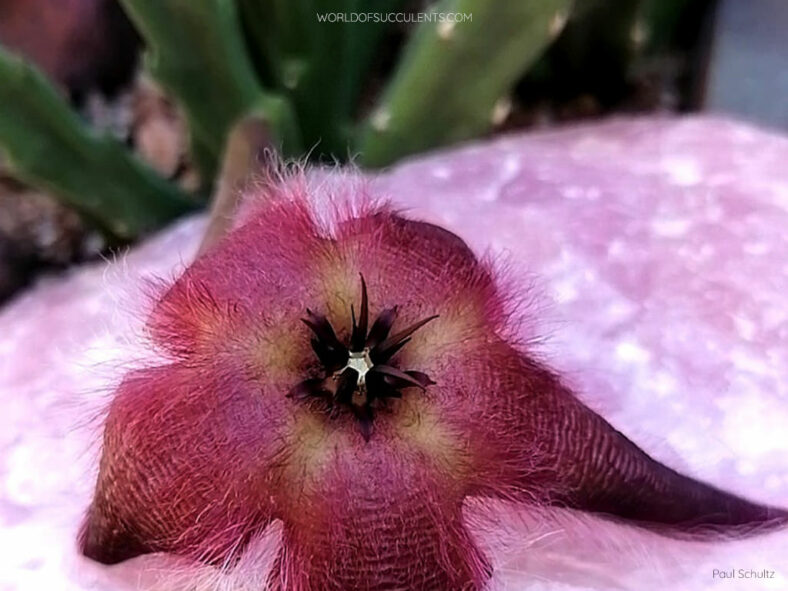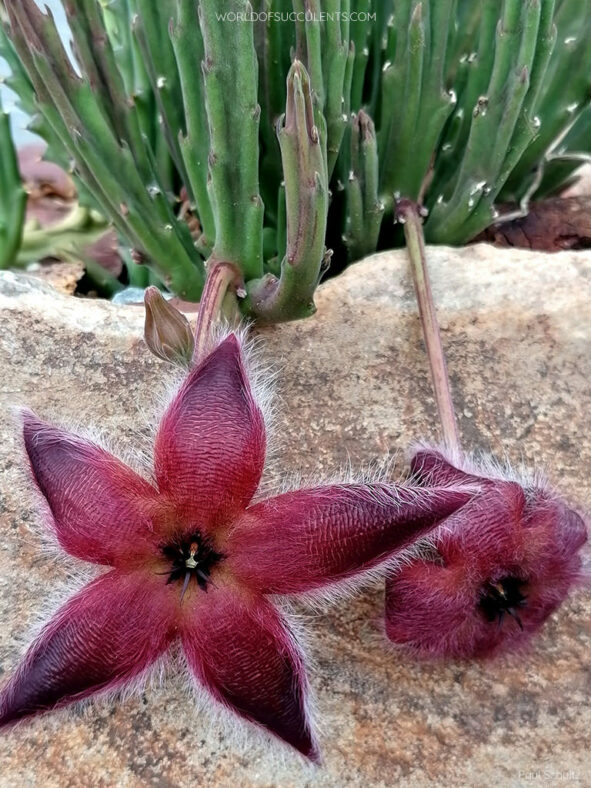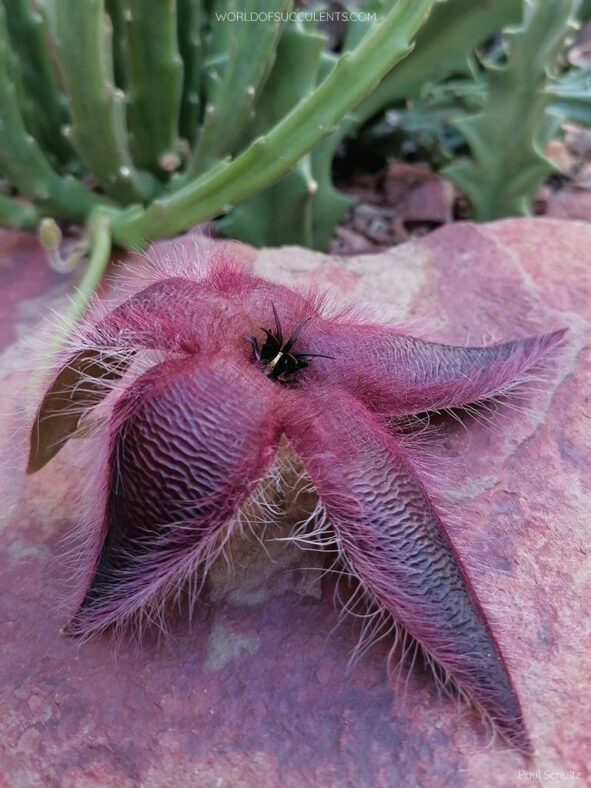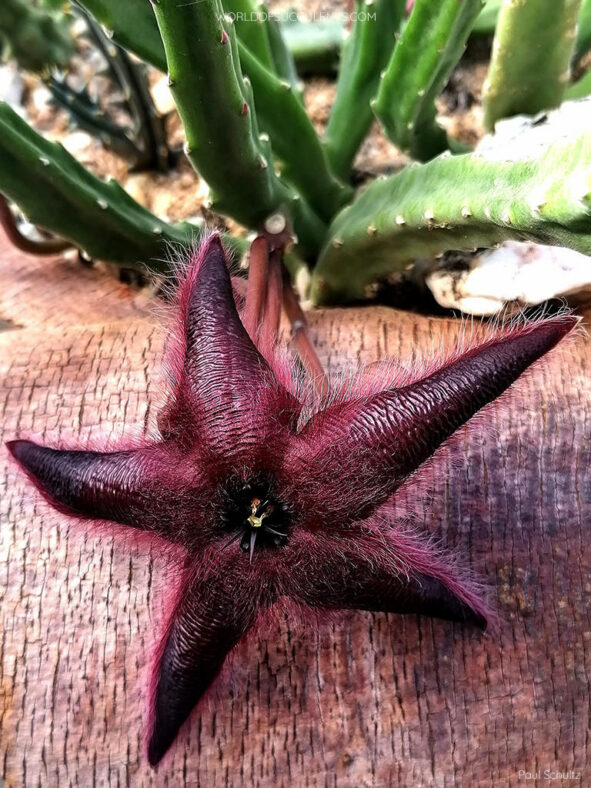Scientific Name
Stapelia asterias Masson
Synonym(s)
Ceropegia pulvinata, Gonostemon asterias, Gonostemon grandiflorus var. asterias, Stissera asterias, Stisseria asterias
Scientific Classification
Family: Apocynaceae
Subfamily: Asclepiadoideae
Tribe: Stapeliae
Genus: Stapelia
Etymology
The specific epithet "asterias (pronounced ass-TEER-ee-as)" means "starred; a taxonomic genus within the family Asteriidae – the sea stars" and refers to the flowers which look very much like starfish or sea stars.
Origin
Stapelia asterias is native to southern South Africa. It grows on stony, often sandstone slopes in the Western Cape province.
Description
Stapelia asterias is a small, much-branched succulent that forms dense clumps of green, finely hairy stems with red mottling. The stems are erect with small conical tubercles widely spaced along the stem and joined into four angles. They can grow up to 8 inches (20 cm) tall and 0.8 inches (2 cm) thick. The leaves are reduced to tiny and short-lived rudiments at the tip of the tubercles.
During late summer and fall, the plant produces clusters, one per stem, with 1 to 3 large star-shaped flowers at the base of the stems. The flowers open in succession on stalks that can grow up to 2.8 inches (7 cm) long. The corolla is deeply lobed and can reach a diameter of up to 5 inches (12.5 cm). It is dark purple-brown, more intense at the tips of the lobes, with soft hairs around the corona and along the margins of the lobes. The inner surface of the corolla has transverse wrinkles and irregular lemon-yellow lines on summits of the ridges, fading towards the margins and tips of lobes. The corona in the center of the flowers is about 0.5 inches (1.2 cm) in diameter, blackish-purple, with five linear outer and five lance-shaped inner lobes.
Stapelia asterias is often listed as a synonym of Stapelia hirsuta, but there are some differences. Its stems are not prominently toothed and are densely covered with short, soft hairs. Moreover, the inner surface of the corolla has a characteristic covering of short, weak hairs around the corona and longer and denser along the margins of the lobes. On the other hand, Stapelia hirsuta has stems that are shortly pubescent to more or less smooth and flowers that vary from quite densely hairy in the center to almost entirely smooth.

How to Grow and Care for Stapelia asterias
Light: Stapelia asterias thrives in full sun or partial shade during the hottest summer days. Too much sun causes the stems to develop protective pigmentation or get sunburned. Not enough light leads to weak, thin stems and fewer flowers. Indoors, place the plant near a sunny window.
Soil: The right soil is crucial to growing a healthy plant. Use commercial soil for succulents, or prepare your own mix with 50 to 70 % mineral grit, such as coarse sand, pumice, or perlite.
Temperature: This plant thrives in warm outdoor environments but does not like winter cold. During its winter dormancy, it should remain moderately dry and warm. Stapelia asterias grows best in USDA Plant Hardiness Zones 11a to 11b, with average minimum winter temperatures ranging from 40 to 50 °F (4.4 to 10 °C).
Watering: It has typical watering needs for a succulent. During the growing season, water your plant thoroughly and allow the soil to dry before watering again. In winter, the plant goes dormant and needs almost no water, about once a month.
Fertilizing: To keep it thriving, fertilize during the growing season. Feed with water-soluble fertilizer diluted to half the recommended strength.
Repotting: Stapelia asterias will benefit from fresh potting soil every 2 or 3 years. Repot it in spring, just before the growing season starts. Pick a container with drainage holes.
Propagation: The best way to propagate this succulent is through stem cuttings. However, it is also easy to grow from seeds. To ensure good rooting, take cuttings during the growing season and sow the seeds in spring.
Learn more at How to Grow and Care for Stapelia.
Toxicity of Stapelia asterias
Stapelia asterias has no toxic effects reported. It is safe around pets and humans.
Links
- Back to genus Stapelia
- Succupedia: Browse succulents by Scientific Name, Common Name, Genus, Family, USDA Hardiness Zone, Origin, or cacti by Genus
Photo Gallery
Click on a photo to see a larger version.


